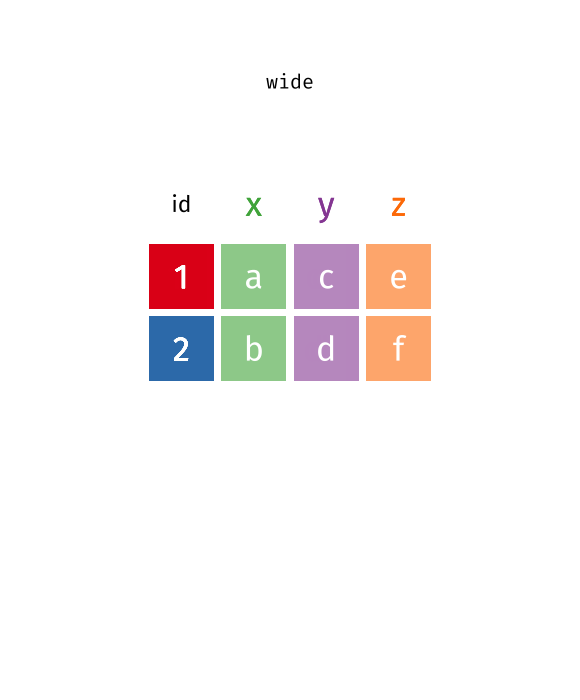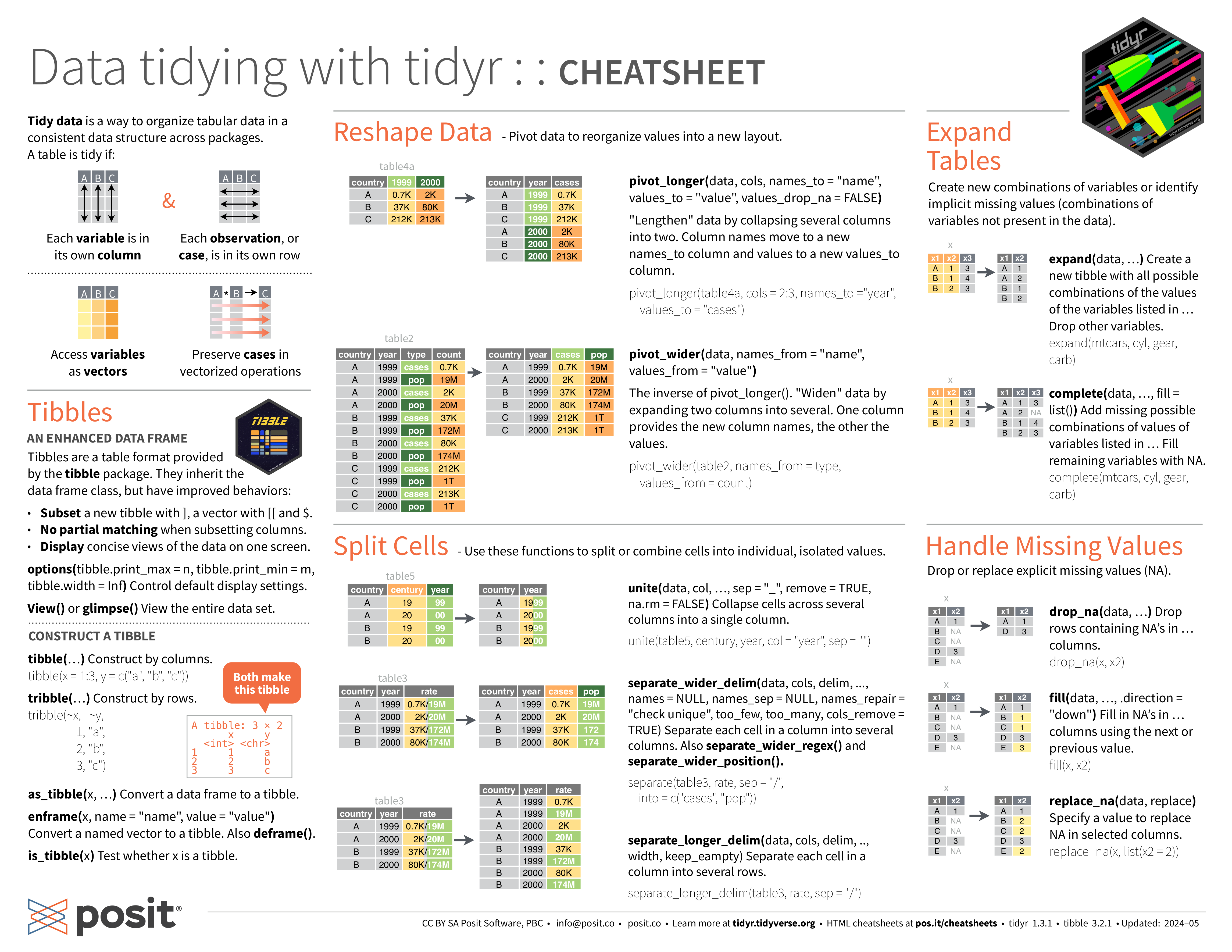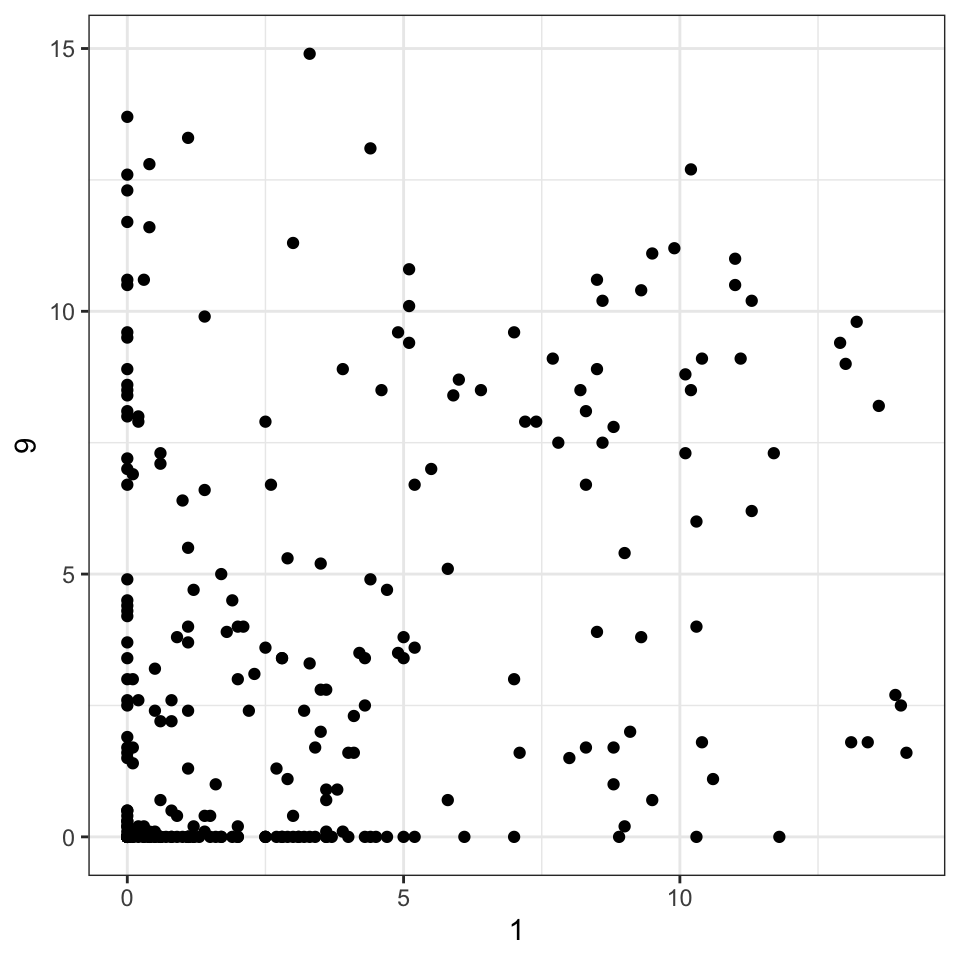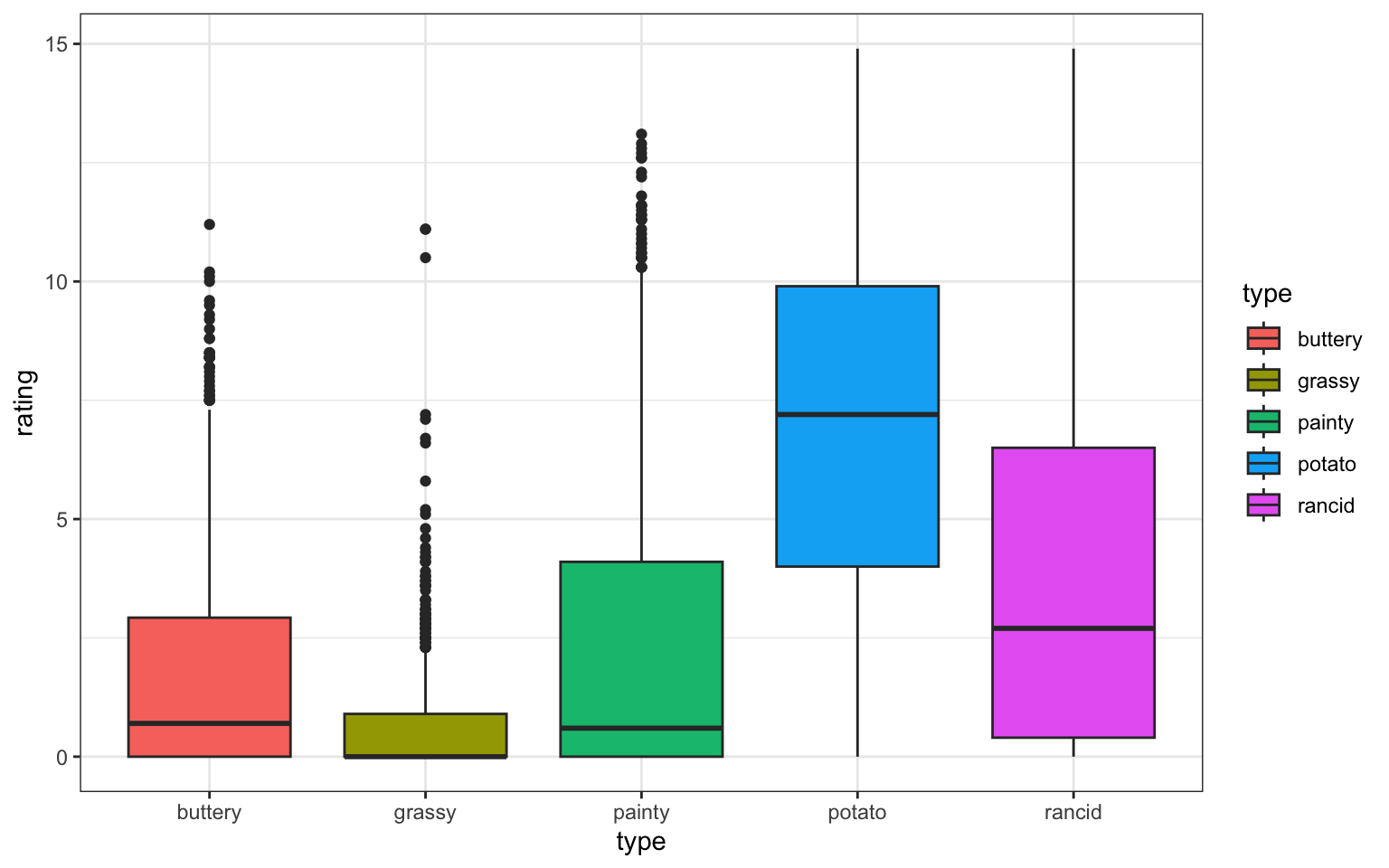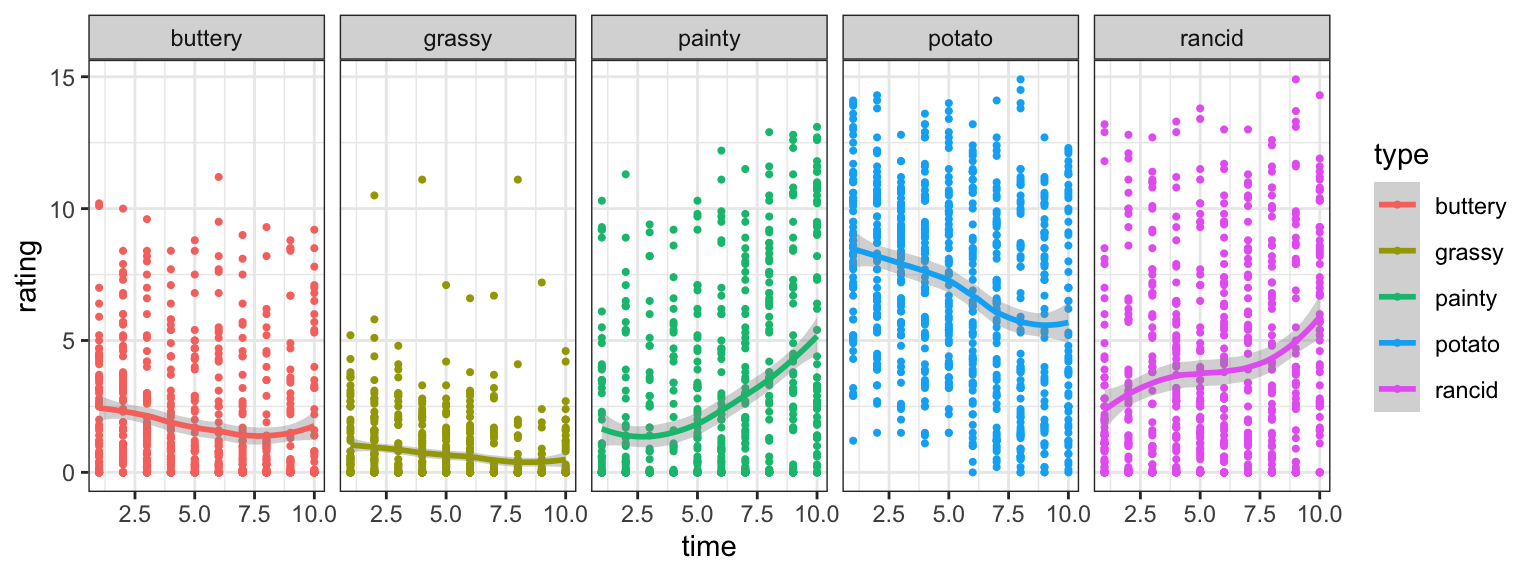# A tibble: 6 × 9
time treatment subject rep potato buttery grassy rancid painty
<fct> <fct> <fct> <dbl> <dbl> <dbl> <dbl> <dbl> <dbl>
1 1 1 3 1 2.9 0 0 0 5.5
2 1 1 3 2 14 0 0 1.1 0
3 1 1 10 1 11 6.4 0 0 0
4 1 1 10 2 9.9 5.9 2.9 2.2 0
5 1 1 15 1 1.2 0.1 0 1.1 5.1
6 1 1 15 2 8.8 3 3.6 1.5 2.3Making a mess again - with the data
SISBID 2025
https://github.com/dicook/SISBID
Warmup
Turn the french_fries data from wide format into a long format with variables type and rating.
05:00 What would you like to find out about the french fries data set?
Put your questions in the chat!
What would we like to know?
- Is the design complete?
- Are replicates like each other?
- How do the ratings on the different scales differ?
- Are raters giving different scores on average?
- Do ratings change over the weeks?
Each of these questions requires a different summary of the data.
Pivot french fries to long
# A tibble: 6 × 6
time treatment subject rep type rating
<fct> <fct> <fct> <dbl> <chr> <dbl>
1 1 1 3 1 potato 2.9
2 1 1 3 1 buttery 0
3 1 1 3 1 grassy 0
4 1 1 3 1 rancid 0
5 1 1 3 1 painty 5.5
6 1 1 3 2 potato 14 Pivot long to wide
Pivot to wide form
tidyr’s pivot_wider function creates variables with comparable values
Long form:
| time | treatment | subject | rep | type | rating |
|---|---|---|---|---|---|
| 1 | 1 | 3 | 1 | potato | 2.9 |
| 1 | 1 | 3 | 1 | buttery | 0.0 |
| 1 | 1 | 3 | 1 | grassy | 0.0 |
| 1 | 1 | 3 | 1 | rancid | 0.0 |
Pivot to wide form
tidyr’s pivot_wider function creates variables with comparable values
Wide form:
| treatment | subject | rep | type | 1 | 2 | 3 | 4 | 5 | 6 | 7 | 8 | 9 | 10 |
|---|---|---|---|---|---|---|---|---|---|---|---|---|---|
| 1 | 3 | 1 | potato | 2.9 | 9.0 | 11.8 | 13.6 | 14.0 | 0.4 | 2.9 | 3.5 | 1.1 | NA |
| 1 | 3 | 1 | buttery | 0.0 | 0.3 | 0.2 | 0.1 | 0.3 | 1.2 | 0.0 | 0.5 | 0.4 | NA |
| 1 | 3 | 1 | grassy | 0.0 | 0.1 | 0.0 | 0.0 | 0.0 | 0.0 | 0.0 | 1.3 | 0.0 | NA |
Pivot to wide form
# A tibble: 6 × 14
treatment subject rep type `1` `2` `3` `4` `5` `6` `7` `8`
<fct> <fct> <dbl> <chr> <dbl> <dbl> <dbl> <dbl> <dbl> <dbl> <dbl> <dbl>
1 1 3 1 potato 2.9 9 11.8 13.6 14 0.4 2.9 3.5
2 1 3 1 butte… 0 0.3 0.2 0.1 0.3 1.2 0 0.5
3 1 3 1 grassy 0 0.1 0 0 0 0 0 1.3
4 1 3 1 rancid 0 5.8 6 1.7 0 0 0 0
5 1 3 1 painty 5.5 0.3 0 0 1.7 9.5 5.5 3.8
6 1 3 2 potato 14 5.5 7.8 5.3 12.9 3.3 0.8 0.6
# ℹ 2 more variables: `9` <dbl>, `10` <dbl>pivot_wider:
- creates a new column for each value of the variable in
names_from - fills values in using the variable in
values_from
Comparing ratings: different weeks
Note the use of the backtick for variable names with special characters or numbers.
Your turn: Are the replicates similar?
Goal: Plot the replicates against each other using a scatterplot.
- Convert the data into long form
- Get the replicates spread into separate columns by replicate.
- Make the plot.
05:00 Are ratings similar across scales?
- Scales: potato-y, buttery, grassy, rancid and painty?
- Pivot into long form, plot with
facet_...(~scale).
# A tibble: 6 × 6
time treatment subject rep type rating
<fct> <fct> <fct> <dbl> <chr> <dbl>
1 1 1 3 1 potato 2.9
2 1 1 3 1 buttery 0
3 1 1 3 1 grassy 0
4 1 1 3 1 rancid 0
5 1 1 3 1 painty 5.5
6 1 1 3 2 potato 14 Are ratings similar across scales?
Side-by-side boxplots
Your turn: Correlation b/w scales?
Create a wide form of the data by type of scale.
corallows you to create a correlation matrix.
Run?corto look up how to get rid ofNAvalues in the result.Draw a scatterplot of two scales with the highest (positive or negative) correlation value.
05:00 Ratings by week
Use the long form of the data and plot:
Your turn: Ratings by time & scale?
- Find a linear model describing the average rating by week (time) and type of scale as shown below.
- Which form of the dataset should we use?
- Challenge: can you plot the fitted lines from the model?
05:00 Resources
- posit cheatsheets
- Wickham (2007) Reshaping data
- R for Data Science (Wickham & Grolemund), chapter 9
- Telling Stories with Data (Alexander), chapters 9 & 10
 This work is licensed under a Creative Commons Attribution-NonCommercial-ShareAlike 4.0 International License.
This work is licensed under a Creative Commons Attribution-NonCommercial-ShareAlike 4.0 International License.
